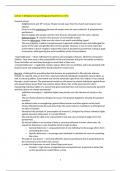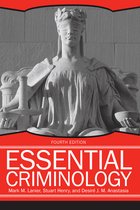Lecture 1: biological and psychological perspective on crime
Classical school:
- Enlightenment and 18th century. People moved away from the church and became more
rational.
- Focus is on the punishment because all people were the same (rational) proportionate
punishment
- Did not explain why people commit crime because all people were the same, rational.
- Rational choice commit crime because of cost-benefit analysis
- Focus on deterrence. Make sure the crime is not worth committing (again).
- This was originally a radical concept because it opposed traditional ways and challenged the
power of the state and glorified the common people. However, it was in some scope also
conservative in that it sought to expand the scope of disciplinary punishment, having it apply
to everyone, while ignoring the social conditions of the crime problems.
´respectable poor´ = those suffering from sickness and contagious diseases, fatherless and pauper
children. They were seen as the responsibility of the ore fortunate and given immediate assistance.
These had fallen on hard times through no moral fault of their own.
‘unrespectable poor’ = vagabonds, tramps, rogues. Were seen as worthless and to be punished with
imprisonment and whipping before being trained for honest work.
Beccaria: challenged the prevailing idea that humans are predestined to fill particular statuses.
Instead, he claimed, they are born free, equal and rational individuals having both natural rights, as
well as natural qualities. Government was not the automatic right of the rich. Rather, it was created
through a social contract. The government would use this power to protect individuals against those
who would choose to put their own interest above others. Part of the government’s role in
maintaining individual rights is to ensure that governing itself does not become excessively powerful
and that citizens are always represented
- Individual sovereignty = individual rights have priority over the interests of society or the
state.
- The law should always be designed to ensure ‘the greatest happiness shred by the greatest
numbers’.
- He defined crime as wrongdoings against fellow humans and thus against society itself.
Crimes offended society because they broke the social contract, resulting in an infringement
on other’s freedom.
- Introduced the principle of ‘presumption of innocence’. Designed to protect individual rights
against excessive state power or corrupt officials.
- Also introduced the right to be represented in trail and a jury instead of judges from the
government.
- He did not believe in an increase of laws or severe punishment to lower crime rates. He
argued for deterrence. Laws should be harsh enough to deter.
o General deterrence = using punishment of one individual to discourage others from
committing the crime
o Specific deterrence = encourage each individual to calculate the costs of commiting
the crime.
- Principle of ‘just desert’ = convicted offenders deserve punishment that is proportionate to
the seriousness to the harm they caused.
- In order for deterrence to work, three things must occur
o Certainty = high chance of apprehension and punishment. Important to know that
certain punishment would follow a crime
1
, o Severity of punishment = must be appropriate. Should outweigh the benefits of the
crime
o Celerity = punishment should be swift after apprehension.
Bentham: he adds the calculus that people act to increase positive results through their pursuit of
pleasure and to reduce negative outcomes through the avoidance of pain.
- People break the law because they want to obtain pleasure.
- Bentham also saw the law as something that would increase the total happiness of society.
- Crimes without victims, consensual crimes and acts of self-defense should not be subject to
criminal law because they produce more good than evil.
- Law should have specific punishment, but because punishment brings more pain, the utility
principle justifies their use only to exclude a greater evil.
- Punishment should be proportionate so the criminal can think on it.
- Bentham believed that with repeating criminals, you should increase the punishment to
outweigh the profit
o Beccaria did not believe in this
- Panopticon.
Limitation of classicism is the notion of equality. Why do some people commit more crime if
everybody is equally endowed with reason??????????
- Limited rationality!
Positivism:
- Challenging divine right and putting emphasize on empirical evidence scientific method
look for rules and patterns experimental method.
- Approach to knowing
- Social, biological and psychological sciences. Humans have unique characteristics, or
predispositions, that, under certain conditions, lead some to commit criminal acts.
o Nature or nurture debate
o Biogovernance = is the propensity towards crime coded in our DNA, or can our
biology be used to detect crime. Using biotechnology to manage potential deviants.
Biological advancements = DNA analysis, brain imaging etc.
Psychological advancements = identification, diagnosis and treatment of
mental disorders.
Study the criminal, not the crime!
Explanations of criminality:
- Biological ‘abnormality’
- Brain functions
- Personality and behavior find their basis in the brain
- Focal damage leads to psychological focal defects.
Biological explanations of crime: some criminal behavior is inherited or innate.
- Phrenology (1796)
o Franz Joseph Gall studied the shape of skulls as indicative of mental capacities and
character traits on a systemic level. He claimed that the mind is a collection of
independent entities housed within the brain. A persons way of thinking is reflected
in the shape of its skull. He divided the brain up in sections and if there were dents in
the skull, then these sections would be altered and could be a reason for crime.
- Cesare Lombroso (positivist)
o He studied the skulls of inmates. More so, the facial features.
2
, o He found that there were 18 atavistic features. If you have at least 5, you are more
prone to criminality because you are less developed evolutionary. You are stuck on a
lower level of development.
Atavism = is a tendency to revert to something ancient or ancestral.
Recurrence of traits of an ancestor in a subsequent generation. Hereditary
throwbacks to less developed evolutionary form. Atavism is a condition in
which characteristics that have previously disappeared in the course of
evolution suddenly reoccur.
o Biological determinism.
o He proposed humanitarian reforms as alternatives to incarceration to prevent crimes
by occasional criminals. The severity of punishment should match the dangerousness
of the criminal.
Lombroso classified four main classes of criminals
1. Born criminals = atavistic responsible for the most serious offenses, and recidivist.
a. Death penalty.
2. Crimes by passion = commits crime to correct the emotional pain of an injustice
3. Insane criminal = could be an imbecile or have an affected brain and is unable to distinguish
right from wrong
4. Occasional criminal
a. Criminaloid = weak of nature and easily swayed by others
b. Epileptoid = suffers from epilepsy
c. The habitual criminal = occupation is crime
d. Pseudocriminal = commits crime by accident.
Lombroso had two students who formed the Italian school. Difference with classical school is that the
free will of the classical school now has become determination. Something is already determined,
there is no free will or rational choice.
- Natural differences (positivist school) instead of equality (classical school)
Italian school Enrico Ferri & Raffaele Garafalo work on the idea of Lombroso of biological features
influencing your proneness to criminality.
- Somatyping (body type)
o William Sheldon looked at the body and which crimes you might commit regarding
your body type. This tells us more about who is likely to be processed through
criminal justice agencies than about what causes crime.
Endomorph = guided by mouth and stomach delinquency and fraud
Mesomorph = aggressive, assertive, violent robbery and manslaughter
Ectomorph = vulnerable, thoughtful, shy thieves.
- Ferri coined the term criminal man and criminal sociology. He believed crime was not a free
choice and therefore it was pointless to retributively punish offenders, preferring the idea of
prevention.
- Garafalo saw crime as an organic flaw that results in a failure to develop both altruistic
sensibility and a moral sentiment for others. He introduced adaptation. Criminals who could
not adapt to society should be eliminated by three methods
o 1) death 2) long term or life imprisonment 3) enforced reparation
Contemporary biological perspectives: do not abandon the concept of free will, but prefer the
concept of ‘conditional free will’. Various factors restrict and channel an individual’s decision to act.
- Twin studies = mutual influence of twins was recognized as being important, not just
genetics. If crime is the outcome of some genetically conveyed heritable factor, then we
3






